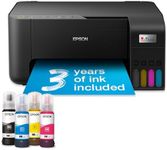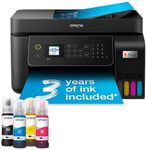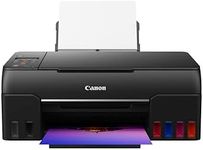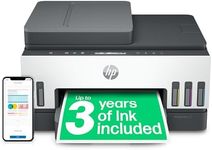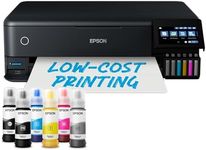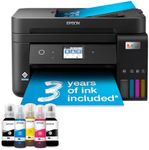Buying Guide for the Best Tank Printers
When choosing a tank printer, it's important to consider your specific printing needs, such as the volume of printing, the types of documents or images you will be printing, and any additional features you might require. Tank printers are known for their large ink reservoirs, which can be more cost-effective for high-volume printing compared to traditional cartridge printers. Understanding the key specifications will help you make an informed decision that aligns with your requirements.Print QualityPrint quality is determined by the printer's resolution, measured in dots per inch (DPI). Higher DPI values generally mean better print quality, which is important for printing detailed images or professional documents. If you primarily print text documents, a lower DPI might suffice, but for high-quality photo printing, look for a printer with a higher DPI. Consider what you will be printing most often to decide the level of print quality you need.
Print SpeedPrint speed is measured in pages per minute (PPM) and indicates how quickly a printer can produce documents. This is crucial if you need to print large volumes quickly, such as in an office setting. Printers with higher PPM are suitable for high-demand environments, while lower PPM might be acceptable for home use where speed is less critical. Assess how often and how quickly you need to print to determine the appropriate print speed for your needs.
Ink Tank CapacityInk tank capacity refers to the amount of ink the printer can hold, which affects how often you need to refill it. Larger tanks are beneficial for high-volume printing as they require less frequent refilling, saving time and effort. If you print frequently or in large quantities, opt for a printer with a larger tank capacity. For occasional printing, a smaller capacity might be sufficient.
Connectivity OptionsConnectivity options include USB, Wi-Fi, Ethernet, and sometimes Bluetooth. These determine how you can connect your devices to the printer. Wi-Fi connectivity is useful for wireless printing from multiple devices, while USB is a straightforward option for direct connections. Consider your setup and how you prefer to connect your devices when choosing a printer with the right connectivity options.
Duplex PrintingDuplex printing allows the printer to automatically print on both sides of the paper, which can save paper and reduce costs. This feature is particularly useful for businesses or individuals who print a lot of double-sided documents. If you frequently need double-sided prints, look for a printer with automatic duplexing. If not, manual duplexing might be sufficient.
Paper HandlingPaper handling refers to the types and sizes of paper a printer can accommodate, as well as the capacity of its paper tray. If you need to print on various media types, such as envelopes or photo paper, ensure the printer supports these. A larger paper tray is beneficial for high-volume printing to reduce the frequency of refilling. Consider the types of documents you print and choose a printer that can handle your specific paper needs.

